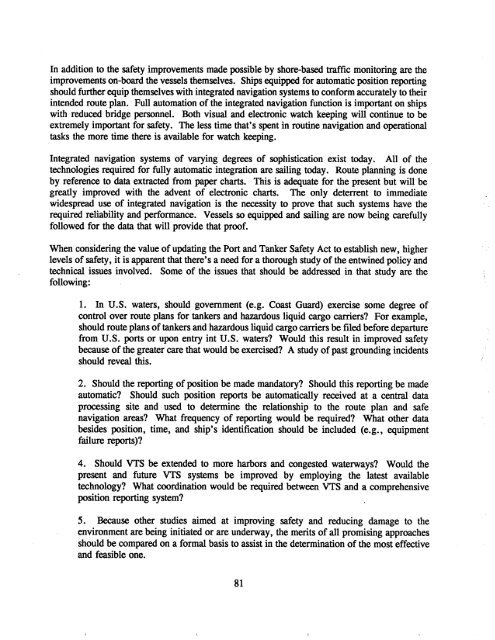WHOI-90-52
WHOI-90-52
WHOI-90-52
You also want an ePaper? Increase the reach of your titles
YUMPU automatically turns print PDFs into web optimized ePapers that Google loves.
In addition to the safety improvements made possible by shore-base trffic monitoring are the<br />
improvements on-board the vessels themselves. Ships equippe for automatic position reportng<br />
should furter equip themselves with integrated navigation systems to conform accurately to their<br />
intended route plan. Full automation of the integrate navigation function is importt on ships<br />
with reduce bridge personnel. Both visual and electronic watch keeping wil continue to be<br />
extremely importt for saety. The less time that's spent in routine navigation and operational<br />
tasks the more time there is available for watch keeping.<br />
Integrated navigation systems of varing degrees of sophistication exist today. All of the<br />
tehnologies required for fully automatic integration are saling today. Route planning is done<br />
by reference to data extrcte from paper chars. This is adequate for the present but wil be<br />
greatly improved with the advent of electronic chars. The only deterrent to immediate<br />
widespread use of integrate navigation is the necssity to prove that such systems have the<br />
required reliabilty and performance. Vessels so equippe and saling are now being caefully<br />
followed for the data that wil provide that proof.<br />
When considering the value of updating the Port and Tanker Safety Act to establish new, higher<br />
levels of saety, it is apparent that there's a nee for a thorough study of the entwined policy and<br />
tehnica issues involved. Some of the issues that should be addresse in that study are the<br />
following:<br />
1. In U.S. waters, should government (e.g. Coast Guard) exercise some degree of<br />
control over route plans for takers and hazdous liquid cago caers? For example,<br />
should route plans of takers and hazdous liquid cago caers be fied before deparure<br />
from U.S. ports or upon entr int U.S. waters? Would this result in improved safety<br />
becuse of the greater cae that would be exercise? A study of past grounding incidents<br />
should revea ths.<br />
2. Should the reportng of position be made mandatory? Should this reportng be made<br />
automatic? Should such position reports be automaticaly recived at a central data<br />
procssing site and use to determine the relationship to the route plan and safe<br />
navigation areas? What frequency of reportng would be required? What other data<br />
besides position, time, and ship's identification should be included (e.g., equipment<br />
failure reports)?<br />
4. Should VTS be extended to more harbors and congeste waterways? Would the<br />
present and future VTS systems be improved by employing the latest available<br />
tehnology? What cordination would be required between VTS and a comprehensive<br />
position reportng system?<br />
5. Beuse other studies aimed at improving saety and reducing damage to the<br />
environment are being initiated or are underway, the merits of all promising approaches<br />
should be compared on a formal basis to assist in the determination of the most effective<br />
and feasible one.<br />
81
















